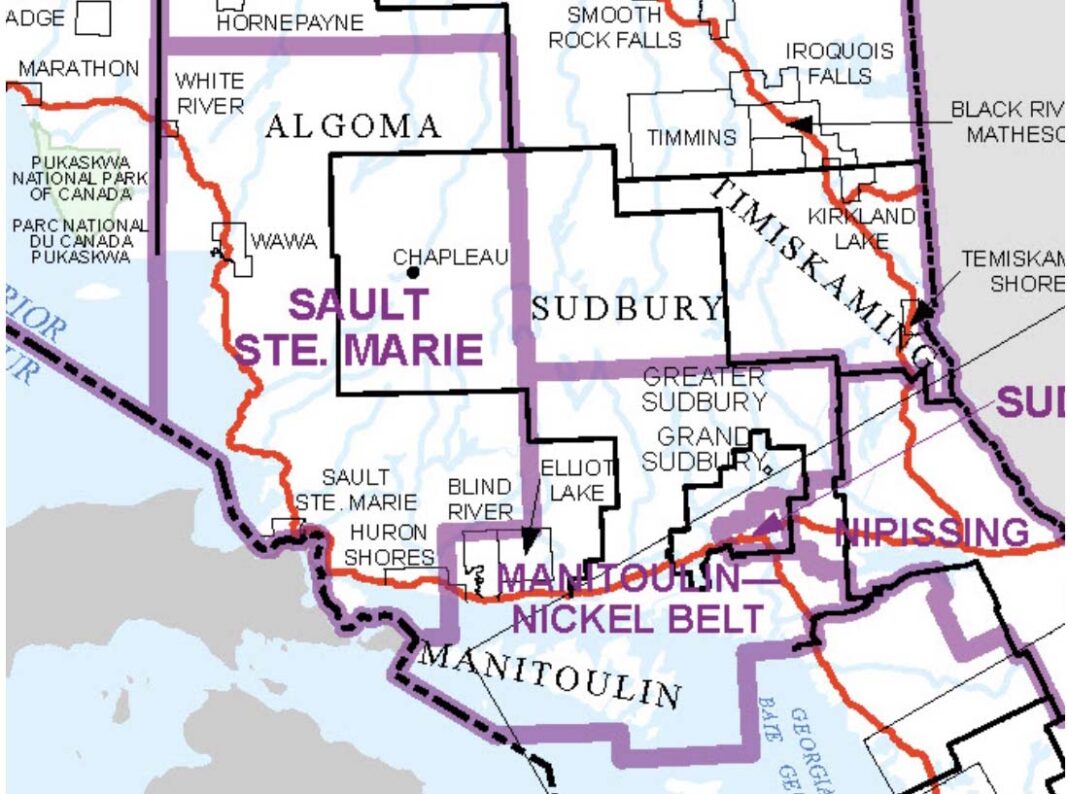NORTHERN ONTARIO—The Ontario Federal Electoral Boundary Commission has submitted its final report on electoral boundaries to the House of Commons and it suggests Northeastern Ontario would drop by one member of parliament.
Every 10 years, following two census counts, all federal electoral districts are reviewed in an effort to maintain approximately equal populations in each riding across Canada.
A similar proposal by the Electoral Boundary Commission was tabled a decade ago,but at that time the suggested loss of a Northern riding did not proceed
The Algoma-Manitoulin-Kapuskasing riding would effectively disappear with its southeastern portion joining a larger Nickel Belt riding, to be renamed Manitoulin-Nickel Belt. The redrawn boundaries would see the Timmins-James Bay riding expand westward to take in Smooth Rock Falls, Kapuskasing, Hearst and Hornepayne, which are currently part of the Algoma-Manitoulin-Kapuskasing riding.
“We are extremely disappointed by the commission’s report and recommendations,” said MP Hughes. “We are looking at options and alternatives to see if, and how, we can oppose this.”
“With the final report, the number of ridings representing Northern Ontario are being reduced from ten to nine,” said MP Hughes. “This proposal means fewer MPs representing much larger ridings, fewer constituency offices that act as the access point for federal services and less funding for important programs like Canada Summer Jobs across the North. We will be losing funding of over $1 million through the Canadian Summers Jobs program. It means that there will be less job opportunities for students, in a larger area and less opportunities employers will have to hire them.”
The boundary commission report notes that access to government services is a serious concern for people and suggests that adding, or even maintaining, electoral districts in Northern Ontario is beyond their mandate and will require an act of Parliament.
“This is just the start, we can’t compete with the increasing population in southern Ontario, although we have population increases in the North as well,” said MP Hughes. They need to rethink this proposal. We don’t have the same access to transportation as the south does with subways and other forms of transportation, and access to other service agencies that we don’t in the north. And we don’t have reliable internet in the North. This all plays a role in servicing individuals.”
“This is not a partisan issue, or about me, this is about our riding, and making sure constituents have better services. The changes are going to make it harder for constituents to have regular services provided in an area,” said MP Hughes. She pointed out that, under the recommendations Sagamok is being removed from the same riding they share with neighbouring Massey. They will now be in two different ridings; Massey would be part of the Manitoulin-Nickel Belt riding and Sagamok would be part of the Algoma-Sault Ste. Marie riding.
MP Hughes said under the new plan, the Brampton riding (which currently has four MPs) will see an additional MP added for a 300 square kilometre city. If you look at Brampton having five MPs for such a small area, it is not acceptable for us in the North to lose a seat.”
MP Charlie Angus told CTV Friday evening, “they have killed the Algoma-Manitoulin-Kapuskasing riding and put it under Nickel Belt.” The Northern portion of the riding, Kapuskasing, Hearst, Smooth Rock Falls and Hornepayne would be added to Mr. Angus’ Timmins-James Bay riding.
“The current proposal hurts people in Northern Ontario,” said MP Angus. “This isn’t a partisan issue. We’ve worked with all Northern Ontario MPs to oppose reducing the number of electoral districts, and I am very disappointed with the submission of this final report. While the new proposed ridings differ from those in the earlier submission, it feels a little like rearranging the deck chairs on the Titanic.”
Marc Serre, Liberal MP for Nickel Belt, said the commission recommendations mean, “less representation, less voice, funding and services for the North.” He told The Expositor, “Removing one seat in Northern Ontario; the bottom line is that it is enlarging the riding significantly.”
“We fought hard and had a lot of representation at the commission’s hearing in Timmins. They identified a lot of concerns. The democratic process is good, but we got caught up in the numbers this time around,” said MP Serre. “We will fight the recommended boundary changes.”
“The commission said the changes will not result in any financial penalties, but we know that summer student jobs funding will be reduced significantly. This is frustrating,” said MP Serre.
“And we had all the political parties together, to make sure we kept all our seats in the North,” said MP Serre. “I have travelled to Manitoulin Island several times in the past and I like the area alot. But the bottom line with the boundary changes is that it means a large increase in the riding, which is already difficult to manage, travel-wise. And it will make it more difficult to attract people to run for office in the North. Representatives will spend half the year driving to and from Ottawa and half the year driving through the riding.”
“We are looking at all our options,” said MP Hughes. “I’ve been in contact with all Liberal MPs and Charlie Angus is in contact with all Conservative MPs. Our options are to oppose the recommendation, or not. If changes are to be made in the boundaries, if we manage to save 10 riding seats in the North, the question is where will they take one MP from the south.”
There remain opportunities for MPs to object to the current proposal. MPs can file an objection to the report to the Standing Committee on Procedure and House Affairs, with the signature of ten other MPs. Objections must be filed by March 12. And discussions among Northern Ontario MPs are ongoing, following the release of the proposal.
After reviewing any objections, the commission is expected to submit its final report to the Speaker of the House of Commons in June.
If the report is accepted, the order to legislate the redistribution for national ridings would be made in September.
The earliest the changes could come into effect would be the spring of 2024, with the next federal election (assuming the government isn’t defeated in the meantime through a confidence vote) slated for October 2025.





